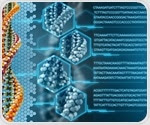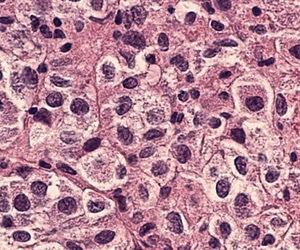| |
 For millions of years, humans and viruses have engaged in a constant tug of war: as our cells evolve new ways to defend us from our viral enemies, these pathogens in turn acquire new traits to sidestep those defenses. For millions of years, humans and viruses have engaged in a constant tug of war: as our cells evolve new ways to defend us from our viral enemies, these pathogens in turn acquire new traits to sidestep those defenses. | |
|
| |
 Researchers from MIT have now developed nanoparticles that could carry CRISPR genetic editing systems deep within the cells and perform their functions on the DNA. The paper was published in the November issue of Nature Biotechnology. Researchers from MIT have now developed nanoparticles that could carry CRISPR genetic editing systems deep within the cells and perform their functions on the DNA. The paper was published in the November issue of Nature Biotechnology. | |
|
| |
 Researchers at Kanazawa University and the University of Tokyo report in Nature Communications the visualization of the dynamics of ‘molecular scissors’ — the main mechanism of the CRISPR-Cas9 genetic-engineering technique. Researchers at Kanazawa University and the University of Tokyo report in Nature Communications the visualization of the dynamics of ‘molecular scissors’ — the main mechanism of the CRISPR-Cas9 genetic-engineering technique. | |
|
| |
 The buildup of plaque in the heart's arteries is an unfortunate part of aging. But by studying the genetic makeup of people who maintain clear arteries into old age, researchers led by UNC's Jonathan Schisler, PhD, have identified a possible genetic basis for coronary artery disease (CAD), as well as potential new opportunities to prevent it. The buildup of plaque in the heart's arteries is an unfortunate part of aging. But by studying the genetic makeup of people who maintain clear arteries into old age, researchers led by UNC's Jonathan Schisler, PhD, have identified a possible genetic basis for coronary artery disease (CAD), as well as potential new opportunities to prevent it. | |
|
| |
 Ann & Robert H. Lurie Children's Hospital of Chicago is one of the few centers participating in ASPIRO, an international Phase 1/2 clinical trial of a gene therapy product called AT132 for X-linked myotubular myopathy – a rare disease characterized by severe muscle weakness, breathing difficulty and early death. Ann & Robert H. Lurie Children's Hospital of Chicago is one of the few centers participating in ASPIRO, an international Phase 1/2 clinical trial of a gene therapy product called AT132 for X-linked myotubular myopathy – a rare disease characterized by severe muscle weakness, breathing difficulty and early death. | |
|
| |
 Establishing the way in which a genetic alteration called a TMPRSS2-ERG gene fusion forms in a prostate cancer, rather than the presence of the gene fusion itself, could help identify patients with prostate cancer with a low risk of spreading, which might determine the best course of treatment for the patient. Establishing the way in which a genetic alteration called a TMPRSS2-ERG gene fusion forms in a prostate cancer, rather than the presence of the gene fusion itself, could help identify patients with prostate cancer with a low risk of spreading, which might determine the best course of treatment for the patient. | |
|
| |
 Socio-cultural and clinical factors as well as healthcare processes were important drivers of a woman's willingness to provide saliva specimens for future cancer research. Socio-cultural and clinical factors as well as healthcare processes were important drivers of a woman's willingness to provide saliva specimens for future cancer research. | |
|
| |
 During differentiation of pluripotent stem cells to cardiomyocytes, the three-dimensional folding of the DNA reorganizes itself. This reorganization of the DNA architecture precedes and defines important epigenetic patterns. During differentiation of pluripotent stem cells to cardiomyocytes, the three-dimensional folding of the DNA reorganizes itself. This reorganization of the DNA architecture precedes and defines important epigenetic patterns. | |
|
| |
 Research released today highlights advances in the use of CRISPR-Cas9 and human induced pluripotent stem cell technologies to identify novel therapeutic targets for neurological disorders such as schizophrenia and addiction. Research released today highlights advances in the use of CRISPR-Cas9 and human induced pluripotent stem cell technologies to identify novel therapeutic targets for neurological disorders such as schizophrenia and addiction. | |
|
| |
 Hassan, a then seven-year-old boy from Germany, in 2015, presented to the doctors with a rare skin disease called junctional epidermolysis bullosa or JEB. This condition leaves the skin thin and papery and easily breakable. It has been compared to “butterfly wings” because of their fragile nature. Hassan, a then seven-year-old boy from Germany, in 2015, presented to the doctors with a rare skin disease called junctional epidermolysis bullosa or JEB. This condition leaves the skin thin and papery and easily breakable. It has been compared to “butterfly wings” because of their fragile nature. | |
|
| |
 An international study has shed new light on the genetic factors associated with Parkinson's disease, pointing at a group of lysosomal storage disorder genes as potential major contributors to the onset and progression of this common neurodegenerative disorder. The study appears in the journal Brain. An international study has shed new light on the genetic factors associated with Parkinson's disease, pointing at a group of lysosomal storage disorder genes as potential major contributors to the onset and progression of this common neurodegenerative disorder. The study appears in the journal Brain. | |
|
| |
 Scientists have stumbled upon a genetic mutation that is found among the Indiana Amish community people that leads to impaired or defective blood clotting but predicts a longer life span for them. The study was published this week in Science Advances. Scientists have stumbled upon a genetic mutation that is found among the Indiana Amish community people that leads to impaired or defective blood clotting but predicts a longer life span for them. The study was published this week in Science Advances. | |
|
| |
 While genetics play a role in the development of Lupus, a systemic autoimmune disease that can attack any organ system in the human body, so do environmental triggers, such as particulates in air pollution and ultraviolet light, explains Gaurav Gulati, MD, a physician-researcher at the University of Cincinnati College of Medicine. While genetics play a role in the development of Lupus, a systemic autoimmune disease that can attack any organ system in the human body, so do environmental triggers, such as particulates in air pollution and ultraviolet light, explains Gaurav Gulati, MD, a physician-researcher at the University of Cincinnati College of Medicine. | |
|
| |
 In biochemistry and cell biology, the most highly studied and developed protein is green fluorescent protein (GFP), which is derived from jellyfish Aequorea victoria. GFP has a remarkable capacity to efficiently radiate visible internal fluorophore that is extremely valuable and naturally attractive. In biochemistry and cell biology, the most highly studied and developed protein is green fluorescent protein (GFP), which is derived from jellyfish Aequorea victoria. GFP has a remarkable capacity to efficiently radiate visible internal fluorophore that is extremely valuable and naturally attractive. | |
|
| |
 New research suggests that following a high-fat diet during lactation-;regardless of diet during pregnancy-;alters RNA activity in breast milk. The changes in genetic material may increase the risk of metabolic disorders such as type 2 diabetes in offspring. The article is published ahead of print in Physiological Genomics. New research suggests that following a high-fat diet during lactation-;regardless of diet during pregnancy-;alters RNA activity in breast milk. The changes in genetic material may increase the risk of metabolic disorders such as type 2 diabetes in offspring. The article is published ahead of print in Physiological Genomics. | |
|
| |
 Genetic editing has been performed in the laboratory until now. Living cells within Petri-dishes have been put under the microscope while gene editing tools such as CRISPR were used to cut, nick and replace parts of the DNA or genome that is defective with bits of DNA that is correct in its sequence. Now doctors in California have attempted to edit cells within a living person. Genetic editing has been performed in the laboratory until now. Living cells within Petri-dishes have been put under the microscope while gene editing tools such as CRISPR were used to cut, nick and replace parts of the DNA or genome that is defective with bits of DNA that is correct in its sequence. Now doctors in California have attempted to edit cells within a living person. | |
|
| |
 Some scientists call it the "final frontier" of our DNA -- even though it lies at the center of every X-shaped chromosome in nearly every one of our cells. Some scientists call it the "final frontier" of our DNA -- even though it lies at the center of every X-shaped chromosome in nearly every one of our cells. | |
|
| |
 A new $10 million gift from University trustees and supporters Louis A. Simpson '58 and Kimberly K. Querrey will create a center at Northwestern University Feinberg School of Medicine to study the effects of environment on the activation and expression of genes. A new $10 million gift from University trustees and supporters Louis A. Simpson '58 and Kimberly K. Querrey will create a center at Northwestern University Feinberg School of Medicine to study the effects of environment on the activation and expression of genes. | |
|
| |
 After years of rigorous research, a team of scientists has identified the genetic engine that drives a rare form of liver cancer. The findings offer prime targets for drugs to treat the usually lethal disease, fibrolamellar hepatocellular carcinoma (FL-HCC), which mainly strikes adolescents and young adults. After years of rigorous research, a team of scientists has identified the genetic engine that drives a rare form of liver cancer. The findings offer prime targets for drugs to treat the usually lethal disease, fibrolamellar hepatocellular carcinoma (FL-HCC), which mainly strikes adolescents and young adults. | |
|
| |
 In a comprehensive analysis of samples from 107 aged human brains, researchers at the Allen Institute for Brain Science, UW Medicine and Kaiser Permanente Washington Health Research Institute have discovered details that will help researchers better understand the biological bases for Alzheimer's disease and dementia in older populations. In a comprehensive analysis of samples from 107 aged human brains, researchers at the Allen Institute for Brain Science, UW Medicine and Kaiser Permanente Washington Health Research Institute have discovered details that will help researchers better understand the biological bases for Alzheimer's disease and dementia in older populations. | |
|
| |
 A leaf-eating beetle has evolved a symbiotic relationship with bacteria that allows the insect to break down pectin -- part of a plant's cell wall that is indigestible to most animals. A leaf-eating beetle has evolved a symbiotic relationship with bacteria that allows the insect to break down pectin -- part of a plant's cell wall that is indigestible to most animals. | |
|
| |
 Hypertension and heart disease arise from many contributing and interacting factors: genetics, food, and exercise, as well as problems with heart, liver, or kidney function. Hypertension and heart disease arise from many contributing and interacting factors: genetics, food, and exercise, as well as problems with heart, liver, or kidney function. | |
|
| |
 Human cells use a timer to divide: each cell gets at least 30 minutes to divide its genetic material between the nuclei of two daughter cells. Human cells use a timer to divide: each cell gets at least 30 minutes to divide its genetic material between the nuclei of two daughter cells. | |
|
| |
 A new UC San Francisco–led study challenges the dogma in oncology that most cancers are caused by one dominant "driver" mutation that can be treated in isolation with a single targeted drug. Instead, the new research finds one of the world's most deadly forms of lung cancer is driven by changes in multiple different genes, which appear to work together to drive cancer progression and to allow tumors to evade targeted therapy. A new UC San Francisco–led study challenges the dogma in oncology that most cancers are caused by one dominant "driver" mutation that can be treated in isolation with a single targeted drug. Instead, the new research finds one of the world's most deadly forms of lung cancer is driven by changes in multiple different genes, which appear to work together to drive cancer progression and to allow tumors to evade targeted therapy. | |
|
| |
 Oxford BioDynamics Plc, a biotechnology company focused on the discovery and development of epigenetic biomarkers based on regulatory genome architecture, for use within the pharmaceutical and biotechnology industry, presented its latest results at the annual meeting of the Foundation for National Institute for Health Biomarker Consortium Cancer Steering Committee, held in Washington, DC on 6-7 November 2017. Oxford BioDynamics Plc, a biotechnology company focused on the discovery and development of epigenetic biomarkers based on regulatory genome architecture, for use within the pharmaceutical and biotechnology industry, presented its latest results at the annual meeting of the Foundation for National Institute for Health Biomarker Consortium Cancer Steering Committee, held in Washington, DC on 6-7 November 2017. | |
|
| |
 Reprogramming denotes changing the state of any form of cell to a pluripotent cell. Induced pluripotent stem cells (iPSCs) are a kind of pluripotent cell generated from adult somatic cells that have been reprogrammed to act as stem cells using specific transcription factors. Reprogramming denotes changing the state of any form of cell to a pluripotent cell. Induced pluripotent stem cells (iPSCs) are a kind of pluripotent cell generated from adult somatic cells that have been reprogrammed to act as stem cells using specific transcription factors. | |
|
| |
 To address the need for low volume genomics, the 0.30 ml tube enables miniaturization of reaction volume required in genomic applications. The automation friendly tube cuts out intermediate (screening) plates and is more accessible for low volume liquid handlers. To address the need for low volume genomics, the 0.30 ml tube enables miniaturization of reaction volume required in genomic applications. The automation friendly tube cuts out intermediate (screening) plates and is more accessible for low volume liquid handlers. | |
|
| |
 The destructive force of UV radiation on DNA molecules is only fully visible, when repair mechanisms fail: patients with the rare genetic disease Xeroderma pigmentosum - also known as 'Moon children' - develop inflammations upon exposure to only small amounts of sunlight, rough-surfaced growths and eventually skin cancer occurs often in early age. The destructive force of UV radiation on DNA molecules is only fully visible, when repair mechanisms fail: patients with the rare genetic disease Xeroderma pigmentosum - also known as 'Moon children' - develop inflammations upon exposure to only small amounts of sunlight, rough-surfaced growths and eventually skin cancer occurs often in early age. | |
|
| |
 The principles of the gene network for colon tumorigenesis have been identified by a KAIST research team. The principles will be used to find the molecular target for effective anti-cancer drugs in the future. Further, this research gained attention for using a systems biology approach, which is an integrated research area of IT and BT. The principles of the gene network for colon tumorigenesis have been identified by a KAIST research team. The principles will be used to find the molecular target for effective anti-cancer drugs in the future. Further, this research gained attention for using a systems biology approach, which is an integrated research area of IT and BT. | |
|
| |
 Doctors have many drugs available to treat multiple myeloma, a type of blood cancer. However, there is no way to predict, by genetic markers or other means, how a patient will respond to a particular drug. This can lead to months of treatment with a drug that isn't working. Doctors have many drugs available to treat multiple myeloma, a type of blood cancer. However, there is no way to predict, by genetic markers or other means, how a patient will respond to a particular drug. This can lead to months of treatment with a drug that isn't working. | |
|
| |
 Researchers at the University of California, Riverside have developed transgenic mosquitoes that stably express the Cas9 enzyme in their germline. The addition of Cas9 will enable the use of the CRISPR gene editing tool to make efficient, targeted changes to the mosquitoes' DNA. Researchers at the University of California, Riverside have developed transgenic mosquitoes that stably express the Cas9 enzyme in their germline. The addition of Cas9 will enable the use of the CRISPR gene editing tool to make efficient, targeted changes to the mosquitoes' DNA. | |
|
| |
 The term “Post-antibiotic apocalypse” may sound a little too alarmist, but it has been coined for a legitimate reason: the decreasing effectiveness of antibiotics against bacterial infections. The term “Post-antibiotic apocalypse” may sound a little too alarmist, but it has been coined for a legitimate reason: the decreasing effectiveness of antibiotics against bacterial infections. | |
|
| |
 We study mammalian cells and try to understand how these cells interact with their environment. We mainly focus on the interactions that can occur with individual ligands. We study mammalian cells and try to understand how these cells interact with their environment. We mainly focus on the interactions that can occur with individual ligands. | |
|
| |
 Tulane University's Stryder Meadows, a cell and molecular biology professor, received a $1.7 million grant from the Department of Defense to study how arteriovenous malformations (AVM), which are defects in arteries, veins and capillaries, form Hereditary Hemorrhagic Telangiectasia (HHT), a genetic disorder that affects about 1 in 5,000 people. Tulane University's Stryder Meadows, a cell and molecular biology professor, received a $1.7 million grant from the Department of Defense to study how arteriovenous malformations (AVM), which are defects in arteries, veins and capillaries, form Hereditary Hemorrhagic Telangiectasia (HHT), a genetic disorder that affects about 1 in 5,000 people. | |
|
| |
 The U.S. Food and Drug Administration today approved Mepsevii (vestronidase alfa-vjbk) to treat pediatric and adult patients with an inherited metabolic condition called mucopolysaccharidosis type VII (MPS VII), also known as Sly syndrome. MPS VII is an extremely rare, progressive condition that affects most tissues and organs. The U.S. Food and Drug Administration today approved Mepsevii (vestronidase alfa-vjbk) to treat pediatric and adult patients with an inherited metabolic condition called mucopolysaccharidosis type VII (MPS VII), also known as Sly syndrome. MPS VII is an extremely rare, progressive condition that affects most tissues and organs. | |
|
| |
 Opioid pain relievers can be extremely effective in relieving pain, but can carry a high risk of addiction and ultimately overdose when breathing is suppressed and stops. Opioid pain relievers can be extremely effective in relieving pain, but can carry a high risk of addiction and ultimately overdose when breathing is suppressed and stops. | |








No hay comentarios:
Publicar un comentario